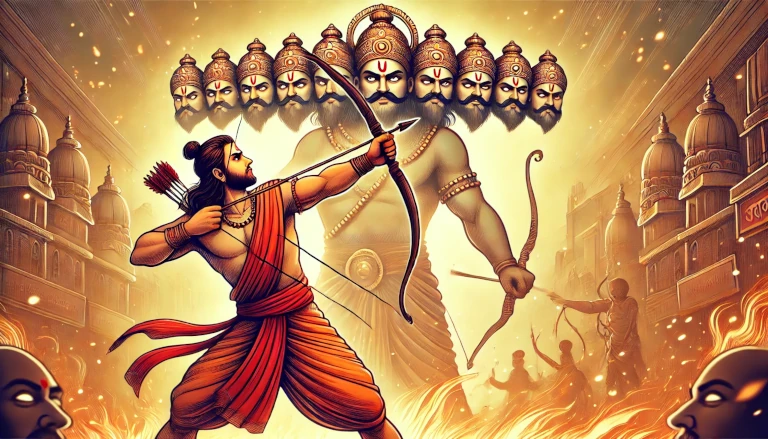Dussehra, also known as Vijayadashami, is one of the most widely celebrated Hindu festivals in India. It marks the victory of good over evil and is celebrated with great enthusiasm and devotion across the country. The festival falls on the tenth day of the bright half of the lunar month of Ashwin (September-October), following the nine-day festival of Navratri.
In this blog, we will explore the significance, history, and traditions of Dussehra in simple and easy-to-understand language so that everyone can grasp its importance and meaning. We’ll also discuss how the festival is celebrated in different regions of India and the life lessons it teaches us.
The Story Behind Dussehra 📖🏹
Dussehra is celebrated to commemorate the victory of Lord Rama over the demon king Ravana. According to Hindu mythology, Ravana had kidnapped Lord Rama’s wife, Sita, which led to a fierce battle between the two. With the help of his devoted brother Lakshmana, and the monkey god Hanuman, Lord Rama defeated Ravana, symbolizing the triumph of righteousness over evil.
This story is recounted in the ancient Hindu epic, the Ramayana, which continues to inspire people to this day.
Another interpretation of Dussehra relates to the goddess Durga, who defeated the demon Mahishasura after a nine-day battle. In many parts of India, Dussehra celebrates the victory of Durga, symbolizing the triumph of divine power over evil forces.
Why is Dussehra Celebrated? 🎉
Dussehra has a deep spiritual and cultural meaning. The festival symbolizes the eternal struggle between good and evil and teaches us that truth, justice, and virtue always prevail. The festival also signifies the victory of dharma (righteousness) over adharma (unrighteousness).
For many, it is a reminder to overcome negative tendencies and weaknesses in their own lives, encouraging people to live with honesty, integrity, and kindness. It serves as a time for renewal, forgiveness, and embracing positive values.
How Dussehra is Celebrated Across India 🏹🔥
Dussehra is celebrated with different customs and traditions across various regions of India. Some of the key ways it is observed include:
1. Effigies of Ravana Burnt in North India 🔥🏹
In many parts of North India, large effigies of Ravana, along with his brothers Meghnath and Kumbhkaran, are set on fire to symbolize the destruction of evil. This is often accompanied by dramatic reenactments of scenes from the Ramayana, known as Ramlila performances, where actors portray the battle between Lord Rama and Ravana.
2. Durga Puja in West Bengal 🌸🙏
In West Bengal, Dussehra coincides with the culmination of the grand festival of Durga Puja, where beautifully crafted idols of Goddess Durga are immersed in water to mark her victory over Mahishasura. The celebrations are filled with prayers, dance, music, and cultural performances.
3. Mysore Dasara 🎠🌺
In the southern state of Karnataka, especially in Mysore, Dussehra is celebrated with great pomp and show. The Mysore Palace is illuminated with thousands of lights, and there is a grand procession featuring the idol of Goddess Chamundeshwari, the family deity of the royal family of Mysore, along with vibrant cultural performances.
4. Shami Puja and Weapons Worship ⚔️🌳
In parts of Maharashtra and Karnataka, people worship the Shami tree and their weapons on Dussehra, marking the importance of valor and righteousness. Ayudha Puja is also performed, where tools, vehicles, and machinery are cleaned and worshipped.
Dussehra: Life Lessons and Moral Values 🌟💡
Dussehra is not just about celebrations; it also imparts important life lessons:
- Good always triumphs over evil: The central message of Dussehra is that no matter how powerful evil may seem, goodness will ultimately win.
- Forgiveness and new beginnings: Just as Lord Rama forgave Ravana’s brother, Vibhishana, Dussehra teaches the value of forgiveness and starting afresh.
- Strength and unity: The story of Rama, Lakshmana, and Hanuman working together to defeat Ravana emphasizes the importance of teamwork and unity in overcoming obstacles.
- Justice and righteousness: Dussehra encourages us to walk the path of truth and justice, even when faced with adversity.
Celebrating Eco-Friendly Dussehra 🌍♻️
In recent years, there has been a growing movement toward celebrating eco-friendly Dussehra. Effigies of Ravana are now being made using biodegradable materials, and there is an increased awareness about minimizing pollution caused by fireworks and waste during the festival.
Here are a few ways you can make your Dussehra celebrations more sustainable:
- Use biodegradable effigies made from paper, bamboo, or clay.
- Avoid excessive use of fireworks, which contribute to air and noise pollution.
- Participate in community clean-up efforts after the festival to keep your surroundings clean.
Dussehra’s Relevance Today 🏹🕉️
Dussehra is a timeless celebration of good over evil, and its values are as relevant today as they were in ancient times. Whether it is through the burning of Ravana’s effigy, the worship of Durga, or the cultural festivities that bring communities together, Dussehra continues to inspire people to strive for righteousness, integrity, and peace.
In an ever-changing world, the message of Dussehra serves as a reminder to always stand for what is right and to be guided by the principles of truth, justice, and compassion.
Discover more from Green Ecosystem - Renewable Energy, Agriculture, and Environmental Sustainability
Subscribe to get the latest posts sent to your email.


